 The Ghana Armed Forces have a small but capable Air Force. The key to their success is training, as we found out during a recent visit to Ghana.
The Ghana Armed Forces have a small but capable Air Force. The key to their success is training, as we found out during a recent visit to Ghana.
Air Vice Marshal Maxwell Mantserbi-Tei Nagai is the current Chief of Air Staff of the Ghana Air Force (GAF). “Our primary role is support of the army and the navy. Next to that we assist with governmental issues, like disaster management. We also support the police and we support Ghana Gas as well. But our main role is support of the army with troop transport, airborne forces, paradropping, fighter ground attack and close air support with the helicopters.” But also aerial photography, transport of the yield of gold mines in the middle of the country and transport of personnel and logistics of the Electoral Commission during elections are part of the tasks.
Accra AFB
Accra AFB is the main airbase of the GAF. Two of the recently acquired C.295s are flying with the Communication squadron, where they replaced the venerable Fokker F-27s. These aircraft have been put through the test in Mali, where the Ghanaian Forces played a big role in the United Nations mission MINUSMA. A terrorist attack at Gao in 2016, damaging a C.295, put an end to that deployment. The damaged aircraft is operational again however. “We fixed it. After the bomb action took place, the pilots ran an engines check on the ground and then they took off and checked the systems. When that was ok, we backloaded it to Tamale and then finally to Accra. We got support from Airbus, and we fixed it in situ, here in the hangar.”
Although the damage to the Casa was caused whilst being operated for the UN, Ghana had to pay the 1.2 million Euro repair bill. When asked about future UN involvement, Nagai is clear: “We have been getting requests from the UN, to support mainly with the helicopter operations in Mali, but right now we are not in position to do so. Possibly when we get new acquisitions, like Mi-35s, then we can consider supporting the UN in that regard. But for now we have too much work meeting our own internal demands.” So as the chief he advised the government that it was in the country’s best interest to reconsider going to Gao, especially with the current security situation.
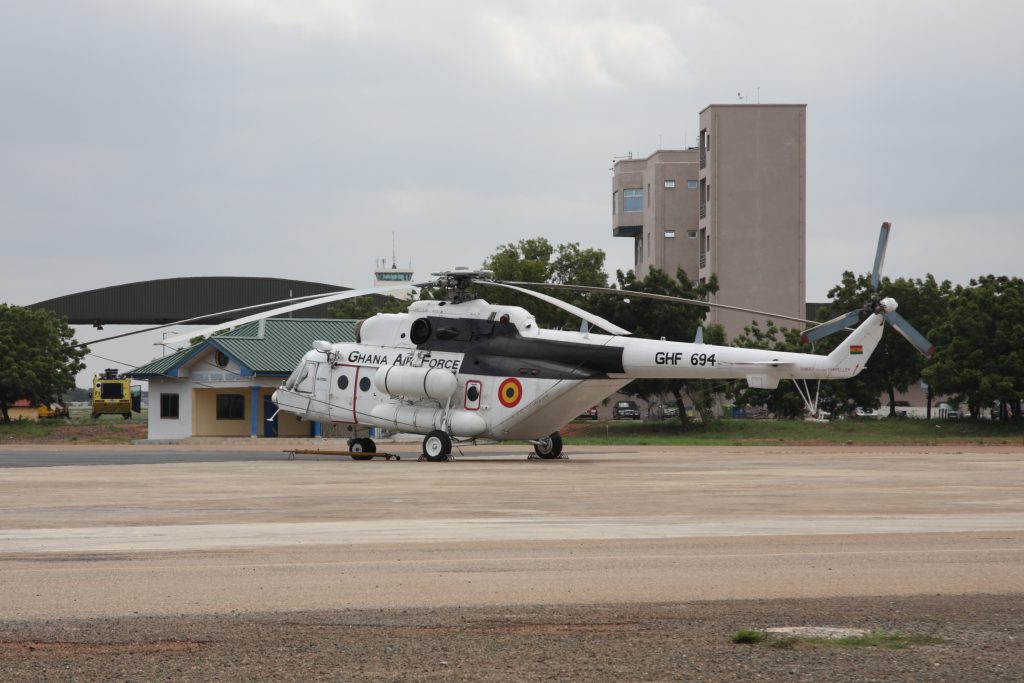
Ghana participated in dozens of UN and ECOWAS missions since the sixties, in which helicopters also played a big role. A recent example was in neighbouring Cote d’Ivoire during the genocide, where A.109 helicopters were used as gunships and Bell 412s for troop transport. These have nowadays been replaced by Z-9 and Mi-17/171 helicopters. All helicopters are operated by 3 squadron and are based at Accra AFB. The main roles of the four Z-9s are gas pipeline and powerline patrols, coastal fishery patrols and ambulance flights. “The Z-9 has two stretchers so it can be used as an ambulance. If the numbers are higher then we go to the Mi-17 that has six stretchers.” says Nagai. They are also equipped with flotation gear for operating over the sea. Furthermore six Mi-17 and Mi-171 ‘Hip’ helicopters fly with 3 squadron and have replaced the Bell 412 in the troop lift role. A few years ago negotiations were held with Rosboronexport in Russia about the possible sale of Mi-35s. “At the time the threat level was assessed, and it was felt that a few gunships would be needed. However, funding turned out to be a problem, and when the security situation changed, it was decided to exchange the planned three Mi-35s for some Mi-171s instead.” explains Nagai. “But the deal is still in the pipeline.” The Hips are equipped with night sun, a hoist and can carry sling loads. They can be armed as well, with an AKS.74 gun on a swivel. The cockpit is not a digital one, although it is NVG capable. There are no plans to upgrade them however. “Suggestions have been made to configure them into some more sophisticated weapons system. But that means we have to ground them, pack them and send them on MRO [Maintenance, Repair and Overhaul] which would take a lot of time. And we need the aircraft now! So we have advised against updating the ones that we have already acquired, but for new acquisitions we will definitely consider this.”
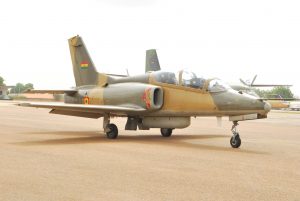 Also flying from Accra AFB are the K-8s of 4 squadron, that have replaced the L-39 and MB.339. “The home base of the squadron is supposed to be in Tamale, but at the time that they arrived, Tamale was not positioned to receive them. Maybe they will move there now, we are thinking about it, if the leadership academy is pulled through.” says Nagai. “The role of the aircraft is strike and fast reconnaissance, mostly on border patrols. The aircraft can be armed for fighter-ground attack. For their training we have a live firing range at Bundase, close by Accra. Since we coordinate with the army during combat, we do air power combat fire training together.” K-8 pilots are selected from the fixed wing training classes and are sent to China for the K-8 conversion.
Also flying from Accra AFB are the K-8s of 4 squadron, that have replaced the L-39 and MB.339. “The home base of the squadron is supposed to be in Tamale, but at the time that they arrived, Tamale was not positioned to receive them. Maybe they will move there now, we are thinking about it, if the leadership academy is pulled through.” says Nagai. “The role of the aircraft is strike and fast reconnaissance, mostly on border patrols. The aircraft can be armed for fighter-ground attack. For their training we have a live firing range at Bundase, close by Accra. Since we coordinate with the army during combat, we do air power combat fire training together.” K-8 pilots are selected from the fixed wing training classes and are sent to China for the K-8 conversion.
Takoradi AFB
Ever since Takoradi AFB was taken over from the RAF in 1961, the Flying Training School (FTS) has been based here. First aircraft to fly were Chipmunks donated by the RAF, later on Beavers, Otters and Caribous were used. The FTS currently formally still operate the venerable Ce.172s, although these haven’t flown for years. Initial flying training is now done on the Diamond Da.42, which is operated by 1 squadron. After a selection process in Accra, student pilots will get their initial 10 hours of flying experience on the Da.42 before they are sent to Bristow Academy for helicopter pilots or Flight Safety Academy for fixed wing pilots, both in the USA. After the period in the USA, the students that are planned to transit to the fixed wing squadrons will come back to Takoradi AFB for follow up training on the Da.42, while the helicopter pilots will go directly to the squadron.
 1 squadron operates three DA.42 aircraft. Of these only one (registered GHF120) fulfils the training role while the other two (GHF121 and 122) are dedicated surveillance aircraft. Next to the three aircraft also a DA.42 simulator has been procured from Diamond to facilitate instrument flying training and in-flight failure training.
1 squadron operates three DA.42 aircraft. Of these only one (registered GHF120) fulfils the training role while the other two (GHF121 and 122) are dedicated surveillance aircraft. Next to the three aircraft also a DA.42 simulator has been procured from Diamond to facilitate instrument flying training and in-flight failure training.
 Main task however of 1 squadron is surveillance. The ISR capability of the Ghana Air Force comes from the two surveillance DA.42s, which are both equipped with the SAFIRE sensor suite. The aircraft were modified in the UK by DO systems Ltd, that also supplied a dedicated DA.42 crewman trainer simulator. Their main roles are maritime surveillance, reconnaissance and internal security operations for the police forces. A regular crew consists of one pilot and one crewman who operates the sensors. A typical maritime surveillance mission can take up to 12 hours and can be flown in both day and night under VFR and IFR conditions. The Hawkeye system allows real time transmission of sensor data, depending on internet availability though.
Main task however of 1 squadron is surveillance. The ISR capability of the Ghana Air Force comes from the two surveillance DA.42s, which are both equipped with the SAFIRE sensor suite. The aircraft were modified in the UK by DO systems Ltd, that also supplied a dedicated DA.42 crewman trainer simulator. Their main roles are maritime surveillance, reconnaissance and internal security operations for the police forces. A regular crew consists of one pilot and one crewman who operates the sensors. A typical maritime surveillance mission can take up to 12 hours and can be flown in both day and night under VFR and IFR conditions. The Hawkeye system allows real time transmission of sensor data, depending on internet availability though.
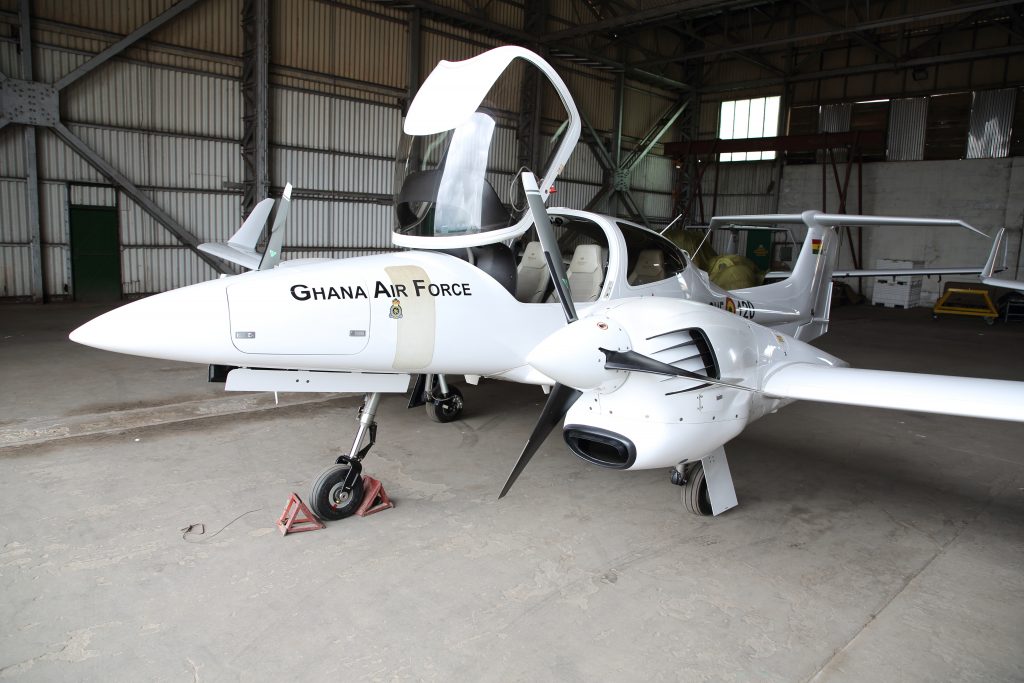
The Diamonds also contribute to the international organisation Oceans Beyond Piracy. Together with Ivory Coast, Togo, Benin and Nigeria, Ghana is responsible for Zone E and Zone F in the Gulf of Guinea. “There is cooperation between the navies and among the air forces, in securing the coasts of these countries. So we do joint exercises at sea with the navy, with helicopters, for example rappelling the special forces onto the ships.” The Diamond is also successful in the fight against drug trafficking: “For this we support the navy as well. Like one time the Diamond had to fly 350 nautical miles into sea to bust a cocaine ship. This mother ship was anchored there and was offloading the goods on smaller ships. And with collaboration of the British and the Americans they got spotted. But how to go in there? The navy could only go to 200 NM, so we scrambled the Diamond that was already flying and sent it there. We took the pictures that were needed as evidence.”
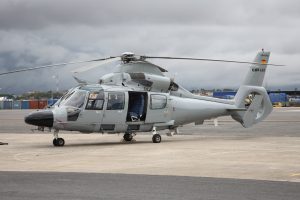 There is also a Z-9 detachment at Takoradi, operating under 1 squadron. Nagai: “Their base is here, in Accra. But at any time we have one or two Z-9s in Takoradi, just in case Ghana Gas requires it. So we don’t have to fly it from here to there before we start our patrols.” Multiple oil and gas winning companies fly their helicopters from here as well, operating from a large brand new hangar built by the air force.
There is also a Z-9 detachment at Takoradi, operating under 1 squadron. Nagai: “Their base is here, in Accra. But at any time we have one or two Z-9s in Takoradi, just in case Ghana Gas requires it. So we don’t have to fly it from here to there before we start our patrols.” Multiple oil and gas winning companies fly their helicopters from here as well, operating from a large brand new hangar built by the air force.
Training
Besides these operational aircraft Takoradi AFB also houses a newly built Air Force Recruit Training School since July 2018. Here basic military training for new airmen is done as well as on-the-job training for when they pass out. Also all personnel will be trained here that will be sent out for future United Nations missions.
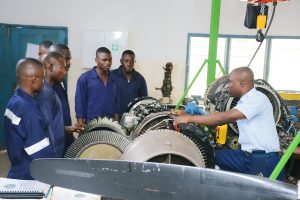
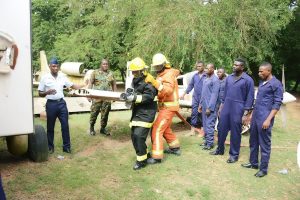
Every year 5-15 student pilots get their wings. Furthermore there is cooperation with the outside world regarding technicians. “The university of Ghana [based in Accra town, authors] started running an aerospace engineering program. They requested for a decommissioned aircraft that can be used as a mock up training device. So we delivered an MB.339, and our engineers put it back together and connected the power so the systems can be run for training purposes.” Also based at Accra AFB is the School of Trade Training (SoTT), where a wide range of skills is taught to students. Here as well is collaboration with the civil world. “Students from the aerospace engineering department of the Kwame Nkrumah University come here for six weeks every year for practicals. After that we are inundated with applications to join. So it’s good for us because they come and see what follow up career they can have. Some airlines also send their technicians to do a course at the SoTT, showing the good collaboration we do with in civil aviation.”
Tamale AFB
The smallest of the three airbases currently regarding flying operations is Tamale AFB, which was built in 1966 with help of the former Soviet Union. One of the Casa 295s is based here, flying with 2 squadron, although at the time of writing this was undergoing its initial heavy maintenance with Airbus in Spain after being in service for six years. Nagai explains “Most of the tasks for the transport aircraft originate from Accra. But this aircraft is based there because of the airborne forces which are also based at Tamale. Its main task is supporting them during their parachute jumping training and deployments and such.” Also assisting in this training is F-27 G521. This aircraft had the honour of making the last operational flight of the type in 2013, when it was delivered here for ground training of the paras and also for technicians. “The Fokker 27 and 28 have done something like 35 years. They’ve really served us very well.” says Maxwell. “Ask the engineers on the F-27 and they will tell you, they would love to go back to Fokker. But of course Fokker has folded up, we‘re not getting spare parts anymore, and they have done their duty. So they were decommissioned. And still in the process is the last one to be decommissioned, the Fokker 28.” This VIP-aircraft, that used to fly the president of Ghana, is for sale and is kept in flyable condition. Its engines are being run regularly.
The Communication squadron nowadays flies the president in a Falcon 900EX which at the time of our visit was in France for a C-check. “This aircraft is on the civil register, so the maintenance regime is strictly by the civil aviation regulations.”
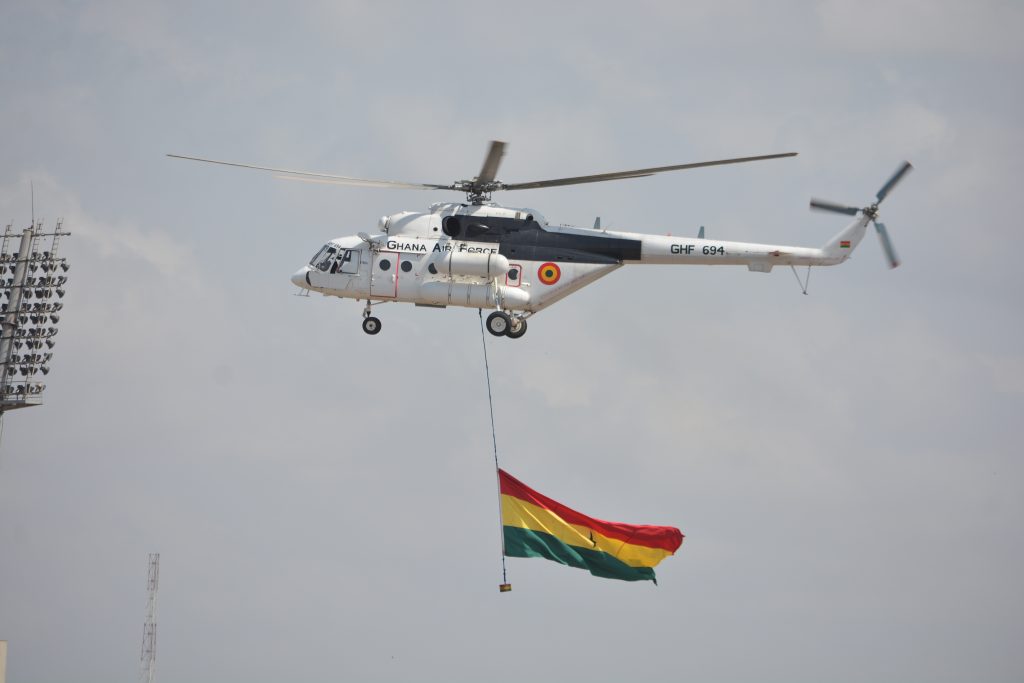
Future developments
When asked about the future, Nagai tells about the plan to establish an air force base in the centre of the country, around Atebubu. “Plan is to establish a helicopter squadron there, so from there we can reach the North and also the South. Furthermore there are plans to have a joint FOB with the navy somewhere In the West, because of the oil find. All these are still on the drawing board, and we are currently technically working towards there. But the final approval of course needs to come from the government.” Nagai continues: “So there are plans to expand. The air force is already much bigger than when I joined in 1980. But as the economy grows and the population grows, there will be new requirements.”
Regarding adding new aircraft to the fleet, the Super Tucano is high on the wish list of Nagai. “In 2013 this came up. The Chief of Air Staff at the time assessed the threat level and we looked at the capabilities of the Super Tucano, and we recommended the government to have it. It would be used both as a strike aircraft and a trainer. You know, because it could do both. So far it didn’t get put though, but we had a long cooperation with the manufacturers in Brazil, and the negotiations are not closed totally. Because we still need it, and while we are also looking for alternatives, the Super Tucano remains the key in our new acquisitions.” Intention was to get four aircraft and one simulator. He continues: “We plan to base them at Tamale AFB to re-establish the Flying Training School there, attached to the brand new Air Force Leadership Training School that we have in Tamale now. Because of the traffic of all oil company helicopters at Takoradi, where the FTS is currently based, we thought it better to relocate to Tamale and then start with the Super Tucano. A very smart hangar has already been built there, to receive the Super Tucano.”
Currently there are no plans to get additional helicopters for the coming three to five years. An option for a fourth C.295 will not be lifted for now.
Finally focus has been and will be for the coming years on personnel, both on training level and comfort. “We try to increase the housing stock for the air force personnel, because that’s a very serious command challenge. And we try to train people, for which we’ve run set courses on our own. In the past we depended on the programme for the whole armed forces, and there was a very big backlog. So we had to find money, locally, within the air force that we use to do these training and to improve the working environment for our troops. We believe that if the soldier is happy, well trained and has a place to put his head, he will come to work leaving the home baggage at home, do his work, and we get a good product.” And based on both reputation and results, this works out well indeed!
We would like to thank Air Vice Marshal Maxwell Mantserbi-Tei Nagai for the warm welcome and the time he took for the interview, and also Squadron Leader Francisca Aholo without whom this article would not have been possible!
Profile of Air Vice Marshal Maxwell Mantserbi-Tei Nagai, Chief of Air Staff
 Air Vice Marshal Maxwell Mantserbi-Tei Nagai is the Chief of Air Staff of the Ghana Air Force since January 2016. He graduated at the Military Academy, Whistler Barracks, Accra in April 1980. He got his wings in 1990 and accumulated some 6,400 flying hours since. Most of these hours were done on helicopters, including most types the Ghana Air Force did have or still fly, such as Alouette III, Agusta A.109, Bell 412, Mil Mi-17/171 and Harbin Z-9. He also flew the Diamond Da.42.
Air Vice Marshal Maxwell Mantserbi-Tei Nagai is the Chief of Air Staff of the Ghana Air Force since January 2016. He graduated at the Military Academy, Whistler Barracks, Accra in April 1980. He got his wings in 1990 and accumulated some 6,400 flying hours since. Most of these hours were done on helicopters, including most types the Ghana Air Force did have or still fly, such as Alouette III, Agusta A.109, Bell 412, Mil Mi-17/171 and Harbin Z-9. He also flew the Diamond Da.42.
Before getting to his current position, Nagai served amongst others as commander of the helicopter squadron at Accra AFB, commanding officer of the flying wing at Accra, base commander at Takoradi AFB and later at Accra AFB. He also acted as Chief Air Operations Officer during the UN mission UNIKOM in Kuwait and was commander of the Ghana Aviation Unit during two periods of the UN Peacekeeping Operation in La Cote d’Ivoire (UNOCI).
This article was published in different shapes in the following magazines (click to see them): Air Forces Monthly, African Aerospace and Global Aviator.
